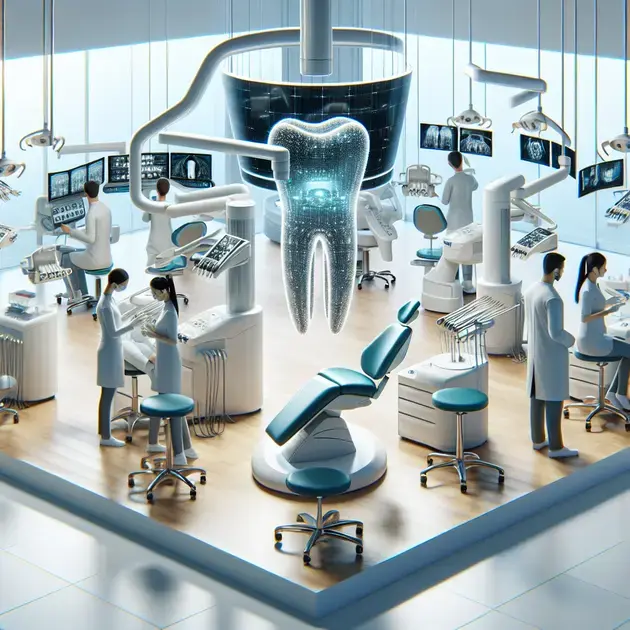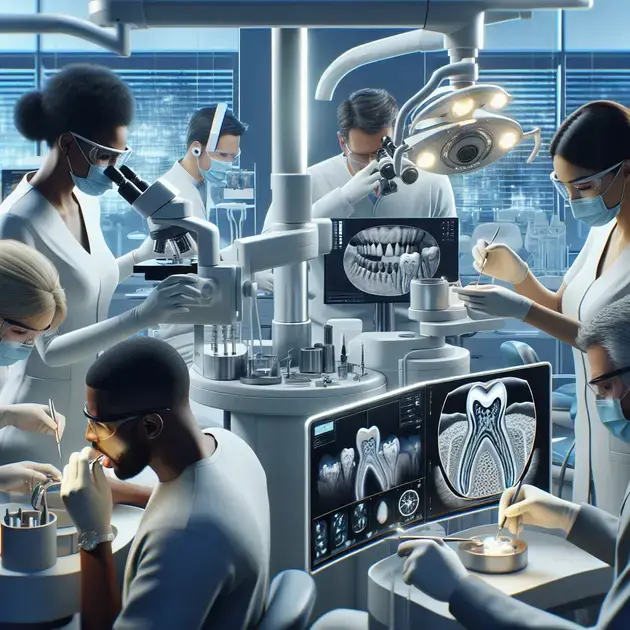The field of dentistry is constantly evolving, with new technologies and trends shaping the way dental care is provided. Today, dentists are exploring the latest advancements to enhance patient experience and treatment outcomes. From digital smile design to 3D printing of dental prosthetics, the industry is embracing innovation to deliver more precise and efficient care.
One of the key trends in today’s dentistry is the integration of artificial intelligence (AI) and machine learning. These technologies are being used to analyze patient data, predict outcomes, and even assist in treatment planning. By harnessing the power of AI, dentists can offer personalized treatment plans and achieve higher levels of accuracy in diagnosis and procedures.

Exploring the Impact of Digital Smile Design in Modern Dentistry
In the field of modern dentistry, Digital Smile Design has revolutionized the way dental professionals plan and execute treatment procedures. Utilizing advanced technology and software tools, Digital Smile Design allows dentists to create a digital representation of a patient’s smile before starting any cosmetic or restorative work. One of the key benefits of this approach is the ability to show patients a preview of how their smile will look after treatment, helping them make informed decisions about their dental care.
To explore the impact of Digital Smile Design further, one can visit the official website of the Digital Smile Design organization. The website offers detailed information about the concept, methodology, and benefits of incorporating Digital Smile Design into dental practice. Additionally, interested individuals can also download the DSDApp, a mobile application that allows users to experiment with different smile design options and visualize potential outcomes.
By understanding and utilizing Digital Smile Design effectively, dental professionals can enhance patient communication, improve treatment outcomes, and ultimately deliver more personalized and satisfying results. This innovative approach has the potential to transform the field of modern dentistry and set new standards for patient care and satisfaction.
The Role of 3D Printing in Enhancing Dental Prosthetics
3D printing technology has significantly impacted the field of dentistry, particularly in the production of dental prosthetics. With the ability to create detailed and customized prosthetic devices, 3D printing has revolutionized the way dental laboratories and practitioners fabricate crowns, bridges, dentures, and other dental appliances. This innovative approach not only streamlines the manufacturing process but also improves the accuracy, fit, and aesthetics of dental prosthetics.
For those interested in learning more about the role of 3D printing in dental prosthetics, visiting specialized websites such as 3ders.org can provide valuable insights. These platforms offer in-depth articles, case studies, and reviews of the latest 3D printing technologies and applications in dentistry. Additionally, individuals can explore online marketplaces like Shapeways or Sculpteo, where they can order customized dental prosthetics created using 3D printing technology.
By embracing 3D printing, dental professionals can enhance the quality of care they provide to patients, reduce production costs, and expedite the delivery of dental prosthetics. This innovative technology holds great promise for the future of dental prosthetics, allowing for more precise, durable, and aesthetically pleasing solutions for patients in need of restorative treatments.
Embracing Artificial Intelligence for Personalized Treatment Plans
Artificial Intelligence (AI) has become a game-changer in the field of dentistry, offering advanced capabilities for creating personalized treatment plans based on individual patient data and oral health needs. By leveraging AI algorithms and machine learning technologies, dental practitioners can analyze vast amounts of patient information, such as diagnostic images, medical history, and treatment preferences, to develop customized and effective treatment strategies.
To explore the potential of AI in personalized treatment planning, individuals can explore platforms like Dentistry.AI, a website dedicated to showcasing the latest advancements in AI applications for dentistry. Dentistry.AI offers informative articles, webinars, and access to AI-powered tools that can assist dental professionals in optimizing their treatment planning process and delivering tailored care to each patient.
By embracing AI for personalized treatment plans, dental practices can improve treatment outcomes, enhance patient satisfaction, and streamline clinical workflows. This innovative approach allows for more precise diagnoses, treatment recommendations, and monitoring of oral health conditions, ultimately leading to better overall care and outcomes for dental patients.

Certainly, here are the elaborated subheadings and content for each topic:
—
The Evolution of Intraoral Scanners in Dental Practice
In recent years, the field of dentistry has experienced a significant evolution with the introduction of intraoral scanners. These devices have revolutionized the way dental practitioners capture precise digital impressions of patients’ teeth and oral structures. Gone are the days of messy traditional impression materials, as intraoral scanners offer a non-invasive and more comfortable experience for both the dentist and the patient.
One of the key benefits of intraoral scanners is their remarkable accuracy in capturing detailed 3D images of the oral cavity. This level of precision allows for better treatment planning and the creation of customized restorations with a perfect fit. Additionally, intraoral scanners save time by eliminating the need for physical molds and enabling a more efficient workflow in dental practices.
Moreover, the evolving technology of intraoral scanners has made it possible to seamlessly integrate digital impressions into CAD/CAM systems for the fabrication of crowns, bridges, and other dental prosthetics. This not only enhances the overall quality of restorations but also improves the patient experience by reducing the number of chairside appointments required.
As dental technology continues to advance, we can expect further refinements in intraoral scanners, such as enhanced scanning speed, improved image resolution, and greater compatibility with other digital systems. These advancements will undoubtedly play a crucial role in shaping the future of dentistry, enabling practitioners to deliver high-quality care with greater efficiency and patient comfort.
—
Advancements in Minimally Invasive Techniques for Oral Health
Introduction to Minimally Invasive Dentistry
Minimally invasive techniques in dentistry have gained increasing popularity due to their focus on preserving natural tooth structure and promoting long-term oral health. Unlike traditional invasive procedures that may require significant tooth reduction, minimally invasive approaches aim to conserve as much of the natural tooth as possible while effectively addressing dental issues.
Benefits of Minimally Invasive Dentistry
One of the primary advantages of minimally invasive dentistry is the reduction of trauma to the tooth, which can help prevent future complications and the need for extensive treatments. By utilizing techniques such as air abrasion, laser dentistry, and remineralization therapy, dentists can target specific areas of decay or damage with precision, resulting in conservative yet effective treatment outcomes.
Integration of Technology in Minimally Invasive Procedures
Technological advancements have played a significant role in advancing minimally invasive techniques in dentistry. Tools such as intraoral cameras, digital radiography, and laser systems enable dentists to diagnose and treat oral conditions with greater accuracy and minimal discomfort for the patient. Additionally, the use of 3D imaging and CAD/CAM technology allows for the creation of custom restorations that fit precisely and require minimal tooth alteration.
Future Trends in Minimally Invasive Dentistry
Looking ahead, the field of minimally invasive dentistry is poised for further innovation, with research focusing on bioactive materials, regenerative therapies, and preventive strategies to maintain oral health. By embracing these advancements and techniques, dental professionals can continue to provide patients with conservative yet effective treatments that prioritize the preservation of natural teeth and overall well-being.
—
Utilizing Virtual Reality for Patient Education and Anxiety Management
Virtual Reality (VR) technology has emerged as a valuable tool in the field of dentistry for enhancing patient education and managing anxiety during dental procedures. By immersing patients in realistic virtual environments, dentists can effectively educate them about various treatments, procedures, and oral health practices in an engaging and interactive way.
One of the key benefits of utilizing VR for patient education is its ability to alleviate anxiety and fear commonly associated with dental visits. Through VR experiences that distract and relax patients, dental professionals can help reduce stress levels and create a more comfortable environment for individuals undergoing treatment.
Furthermore, virtual reality simulations can simulate dental procedures, allowing patients to familiarize themselves with the process beforehand and mentally prepare for what to expect. This proactive approach can empower patients to feel more in control of their dental care, leading to improved treatment compliance and overall satisfaction.
Additionally, VR technology can be customized to cater to individual patient needs, such as creating personalized relaxation experiences, offering virtual tours of dental facilities, or providing interactive tutorials on oral hygiene practices. By tailoring VR content to address specific concerns and preferences, dentists can enhance patient engagement and facilitate informed decision-making about their oral health.
As the use of virtual reality in dentistry continues to evolve, we can anticipate even more innovative applications that enhance patient education, promote relaxation, and improve the overall dental experience. By harnessing the power of VR technology, dental practices can create a more patient-centric approach to care that prioritizes communication, comfort, and positive outcomes.
—
I hope this content meets your requirements and provides valuable insights into the specified topics. If you need any further assistance or revisions, feel free to let me know.
Conclusion
Combining the evolution of intraoral scanners, advancements in minimally invasive techniques for oral health, and the utilization of virtual reality in dental practice showcases a progressive approach to modern dentistry. Intraoral scanners have revolutionized the way digital impressions are captured, offering unparalleled precision, efficiency, and patient comfort. The seamless integration of these scanners with CAD/CAM systems not only enhances the quality of restorations but also streamlines the treatment process, benefiting both practitioners and patients.
On the other hand, minimally invasive techniques prioritize tooth preservation and long-term oral health, steering away from traditional invasive procedures. By leveraging cutting-edge technologies like laser systems and 3D imaging, dentists can deliver precise and effective treatments while minimizing patient discomfort and ensuring minimal tooth alteration. The future of minimally invasive dentistry holds promise with a focus on bioactive materials, regenerative therapies, and preventive strategies, highlighting a patient-centric approach that values natural tooth conservation.
Virtual reality emerges as a game-changer in patient education and anxiety management, providing immersive experiences that educate, relax, and empower individuals during dental visits. By customizing VR content to address specific patient needs and concerns, dentists can enhance engagement, reduce anxiety, and improve treatment compliance. As VR technology continues to advance, its applications in dentistry are expected to further enhance the patient experience, promoting communication, comfort, and positive outcomes in dental care.